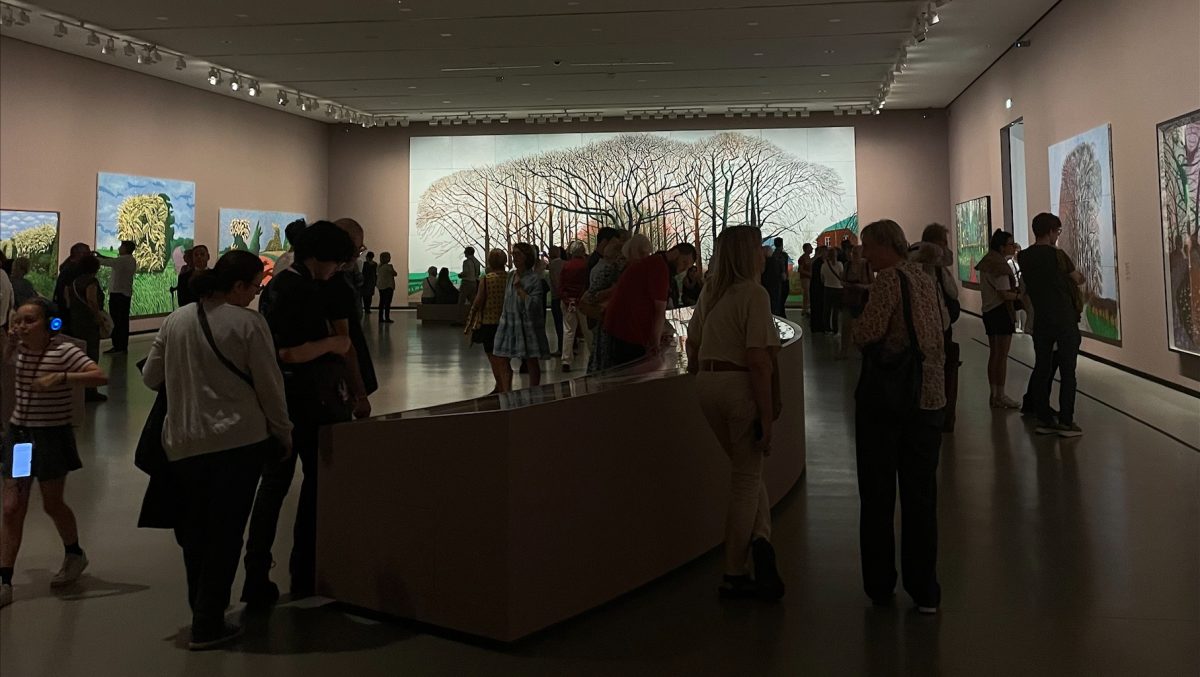In 2011, David Hockney’s fifty-canvas painting Bigger Trees near Warter toured across Yorkshire. I saw it twice that year; once at York Art Gallery, and once at Ferens Art Gallery in Hull. Now, fourteen years later, as a treat for finishing my seven-month-long year abroad placement in the banlieues of Paris, I walked forty minutes from my apartment to the Louis Vuitton Foundation to see it for the third time. David Hockney was born and raised in Bradford, before moving to London for art school, and then to Los Angeles for his career. But in 2005, after the death of his beloved mother, he moved back to Yorkshire and settled in Bridlington, devoting himself to painting the countryside that surrounded him. Warter, the setting and title of this painting, is a village fifteen miles away from the town I grew up in. The Road to York through Sledmere, another artwork in the exhibition, depicted the red brick buildings of Sledmere village, home to the Sledmere Estate. My best friend had worked her first minimum wage job for £4.55 an hour there during our teenage years. Sketches of Langtoft, where I broke my wrist falling off a zipwire; Huggate, where I almost crashed my car on the backroads; and Wetwang, where we traipsed each year for their annual scarecrow festival, were all displayed across the room. ‘J’aime bien cette rue,’ said a woman to her friend pointing at a water colour. Street Scene, Bridlington, or Brid as I know it, depicted a street off the seafront that had free unlimited parking. We had parked there for dog walks, for dance shows, for bodyboarding, for beach-hut holidays, for fish, chips and gravy. Here, four hundred and seventy miles away from East Yorkshire, I was surrounded by my childhood.
When I first moved to France, I had difficulty explaining exactly where I came from. Once the disappointment that I was not from London wore off, ‘The North’ often provided an adequate response. If I felt like being more precise, Yorkshire was a safe bet. On the rare occasion that people pried further, I’d say Hull, then, in response to their blank stares, and with a certain desperation, York, Sheffield, Leeds and, by the end, Manchester. One Dutch girl knew it. She’d done the ferry crossing between Amsterdam and Hull before quickly speeding away on a school coach to a much more favourable part of Britain. I didn’t blame her. I too had spent most of my life desperate to speed away as well. An insular peninsula, East Yorkshire is a haven of tradition, the opponent of change, and a vacuum of gossip and judgement. The county got its first Pret A Manger in 2023, has yet to see a Wagamamas, and still boasts weekly markets, tractor rallies, puppet festivals, mobile libraries and cash-only night clubs. A day out in the city, Northern Rail permitting, included a wander round big Primark, a trip to Trinity Food Market, a stroll through Hull’s best attempt at gentrification (Humber Street), and a seat on the banks of the brown estuary to finish.
I couldn’t help but laugh out loud as an elderly American man looked up house prices in East Yorkshire on his phone, clearly touched and inspired by Hockney’s depictions. He lingered a moment on a house in Driffield, the town I’d spent two nights a week and all my Saturdays in, running about on its hockey pitch. The pitch was continuously covered in a layer of bird shit and, in an effort to scare away the apocalyptically-large seagulls that terrorized the students, they played (with little success) bird of prey noises over several large speakers. The seagulls remained unfazed. I had drunk pints in its pubs, stumbled about on its dance floors and eaten ribbons of kebab meat in its streets. I had been there so often that I used to say I could drive there with my eyes closed. Standing in the middle of the exhibition, I wanted to tell everyone that these were my trees, my farms, my houses, my roads, my towns. As much as I had wanted to leave, I missed the endless fields of the rolling Wolds, speared throughout with the spires of ancient churches. I missed the winter wind that bit at your ears when you walked down the seafront, or through the thick mud of Hockney’s purple woodlands, or down the cobbled high streets filled with twinkling Christmas lights. I missed the welcome-home embrace of the Humber Bridge as the train chugged along the estuary banks, the trips to the farm shops for overflowing sandwiches and double portions of cake, the pubs with sticky carpets and childhood friends, the chips ladened with chip spice in the takeaway, the rugby on the weekend with my dad. Whilst landscapes by nature, Hockney’s pictures were a portrait of me. I had moved to Oxford, I had moved to Paris, but it was still East Yorkshire I loved the most.

